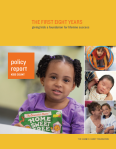
During the 2020 legislative session in Maryland, education advocates worked together in support of the Kirwan Commission recommendations for education reform at the early childhood, primary, and secondary levels.
The Maryland Association for the Education of Young Children (MDAEYC), in partnership with many education organizations throughout the state, advocated for adopting the Kirwan Commission recommendations as part of the Blueprint for Maryland’s Future, the education reform legislation. This Blueprint legislation was introduced and passed in the Maryland House and Senate, and is pending final passage.
As part of the Coalition for the Blueprint for Maryland’s Future, MDAEYC leaders Christina Lopez and Stephanie Schaefer coordinated with coalition partners and participated in a successful advocacy day and Pep Rally in Annapolis in support of the Blueprint legislation. On February 17, 2020, the day the bill was introduced, over 400 hundred educators, families, and advocates attended the pep rally , flooding the hearing room and filling two overflow rooms to watch the hearing remotely. In the morning before the Joint Legislative Hearing, Brit Kirwan and others spoke to the advocates.
Stephanie is proud to have played a role in the advocacy efforts of MDAEYC. In consultation with MDAEYC’s public policy leadership, Stephanie drafted a bill analysis and summary of the Kirwan/Blueprint recommendations, included in MDAEYC’s position statement in support of this landmark education legislation. The position statement filled a need in the early childhood education community by providing a detailed, item-by-item summary of the Kirwan Commission recommendations, making the several-hundred page recommendations more accessible and offering recommendations for its adoption.
The Kirwan Commission (formally titled Maryland Commission on Innovation and Excellence in Education) was established by the Governor and the General Assembly to review and make recommendations for Maryland’s education system. The Kirwan Commission began meeting in 2016, and issued several reports summarizing its recommendations. The most recent report from the Kirwan Commission is the January 2019 Interim Report.
The Commission’s report makes recommendations in five policy areas:
- Early Childhood Education;
- High-quality and Diverse Teachers and Leaders;
- College and Career Readiness Pathways;
- More Resources to Ensure All Students Are Successful; and
- Governance and Accountability.
The key early childhood education recommendations of the Kirwan Commission were included in the Blueprint bill. They are:
- Expand full-day pre-K;
- Support capacity-building for new and current programs;
- Implement a school readiness assessment for all students entering kindergarten; and
- Expand Judy Centers, Family Support Centers, and the Maryland Infants and Toddlers Program.
The provision of Universal pre-K is a critical component of the legislation that will enhance educational equity and access to high-quality early learning for all children in Maryland. MDAEYC supports the Universal pre-K provisions; however, it remains a source of contention for some within the early childhood education community, due to the financial challenges it may create for child care programs, who face a potential loss of many 4-year-olds from their programs. Community-based programs, including child care centers, can apply to provide pre-K, and the funding formula for pre-K expansion requires that by year three, 50% of the pre-K funding is slated to go to community-based providers.
The Blueprint coalition partners look forward to enactment of the Blueprint legislation, and the opportunity to work with colleagues and policymakers to help implement the provisions of this landmark bill.









